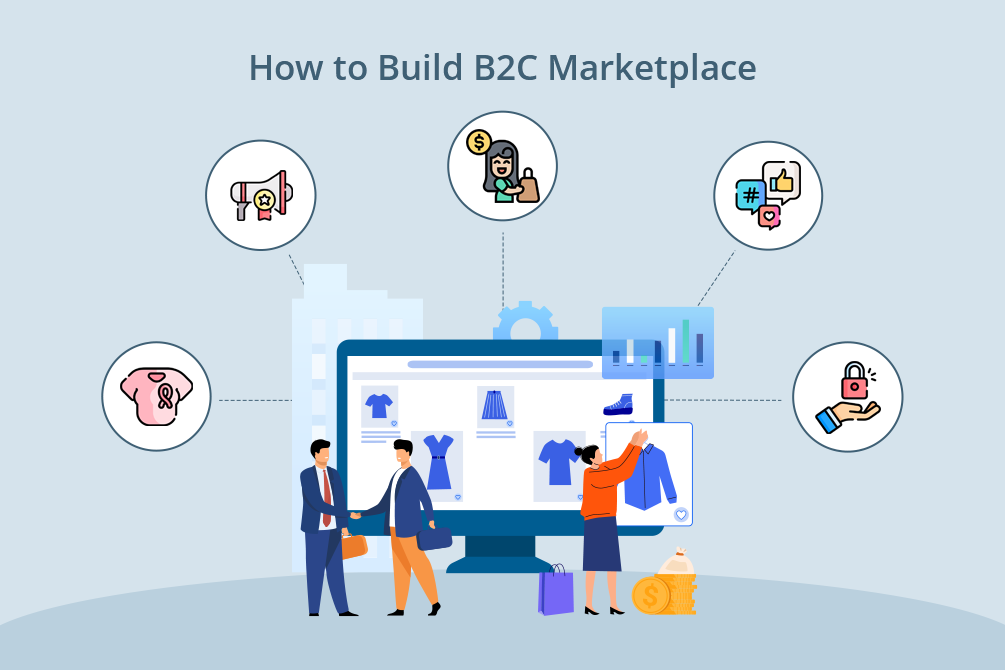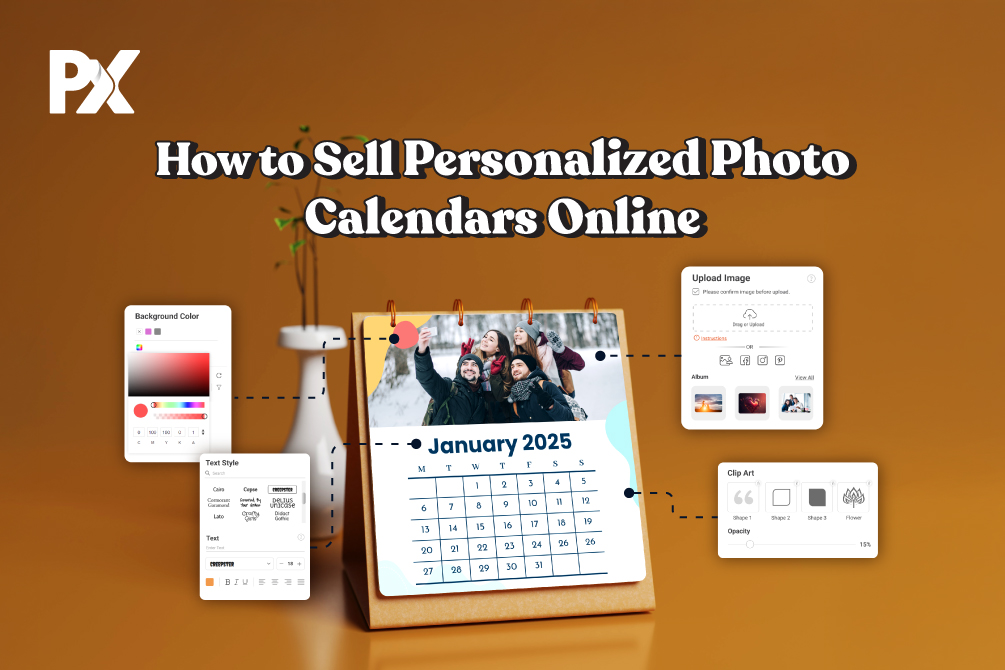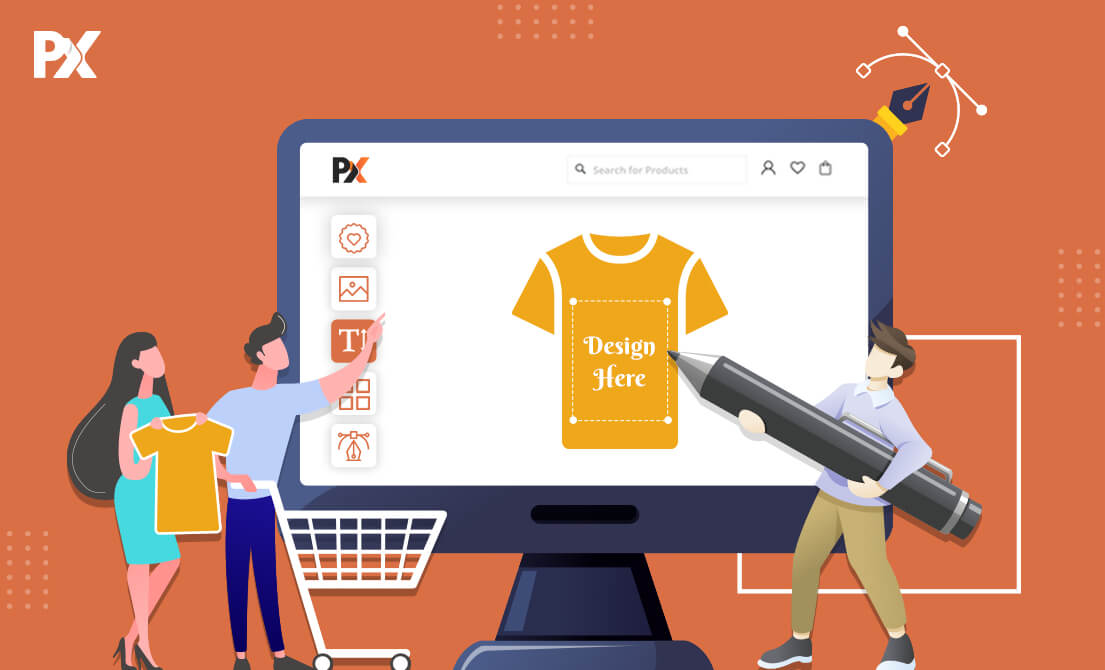Amazon.
No points for guessing; it’s there at the back of your mind all the time.
On some days, you find yourself analyzing the marketplace giant’s secret sauce. On some days, you hate it.
Because, well… How can I compete with Amazon?
This is a common thing for many entrepreneurs when they begin their journey of launching their marketplace.
But here’s the deal: you can, despite the giant’s presence, be successful in launching a marketplace, attract customers, and gradually build a loyal community.
Because for all we know, Amazon sells everything to everybody but (without being great at everything).
However, your business can be great. You can dominate a specific industry you choose to sell.
How? This detailed guide includes everything you need to know to build a B2C online marketplace.
Here’s a quick outline of what this post covers:
- B2C Marketplace: A Quick Overview
- Solving the Biggest Challenge of B2C eCommerce Marketplace
- Identify Who You Want to Target
- Products Are Not Enough. You Need a Brand
- Choose Features that Deliver Success
- A Visually Appealing & Functional Website for the Win
- Do Not Forget eCommerce Fulfilment Process
- Attracting Vendors and Buyers with Right Marketing
B2C Marketplace: A Quick Overview
There has never been a good time to launch a B2C eCommerce marketplace.
The top 100 marketplaces in the world sold $2.67 trillion in 2020.
Marketplace growth is showing no signs of slowing down. Despite the economic slowdown during the pandemic, businesses with a marketplace model see higher growth.
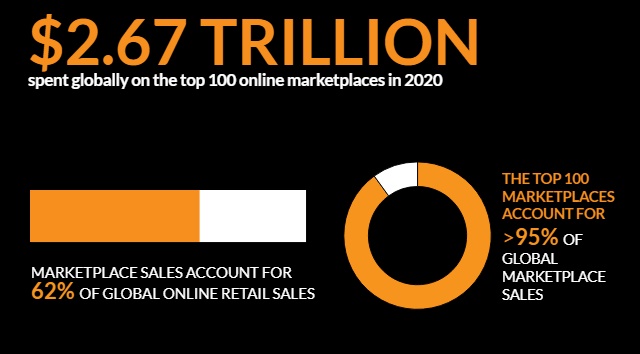
(Top 100 marketplaces in the world sold $2.67 trillion in 2020)
As per an article by Forbes, Etsy’s stock tripled at the height of the pandemic as users started selling custom masks.
More and more businesses are finding ways to leverage the marketplace model to reach a wider audience and grow their business.
? Why is the marketplace business model becoming popular?
- Shoppers find marketplaces more convenient. With the right strategy, you can launch your B2C marketplace platform and gain a loyal customer base.
- Companies with their eCommerce website are expanding to marketplaces to gain more exposure.
- Startups are finding success by targeting niche categories.
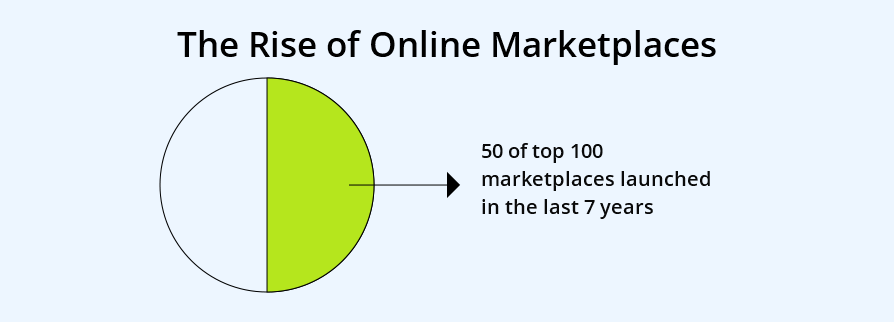
(More than half launched in the last 7 years)
How does the B2C eCommerce marketplace work?
This model includes three stakeholders: marketplace owner (admin), vendors, and end-users. Just like Alibaba, your marketplace works as a platform that includes thousands of vendors offering products.
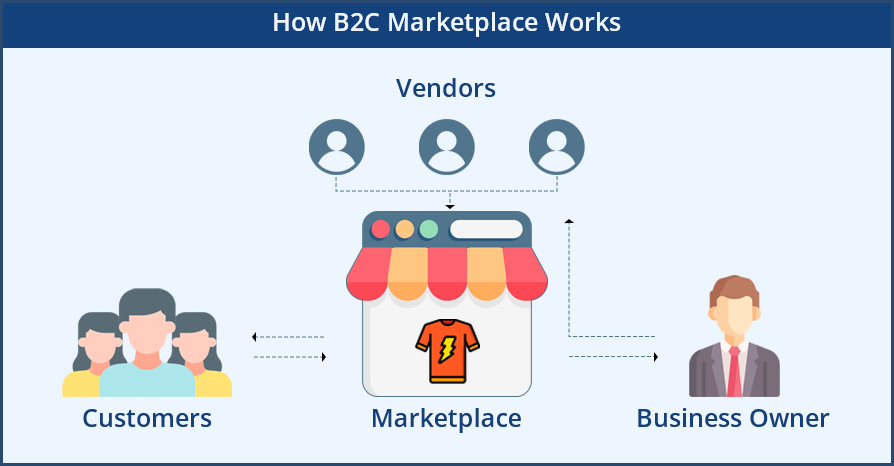
In this model, an admin will hold inventory and basic printing process management. Vendors will have their products. But it depends whether you will be providing printing and fulfillment services, or they will manage themselves.
Build a custom marketplace with our B2C marketplace development services.
Solving the Biggest Challenge of B2C eCommerce Marketplace
48% of online shoppers head straight to large eCommerce Marketplaces. Capturing their attention is a major problem.
For those who want to build a B2C online marketplace, a major challenge is marketplace giants.
They have more capital, resources, and a loyal customer base. Competing with them is not an easy task. You may face the problem of low brand awareness and low customer acquisition.
? Chicken and Egg Marketplace Issue – Who should you target first? Sellers or buyers?
Another challenge in building a B2C marketplace is to solve the chicken and egg problem. For the uninitiated, this issue comes from the famous question: what comes first, an egg or chicken?
What does this mean for marketplace owners?
Typically, a marketplace is where vendors and sellers gather on a platform to buy and sell products. To provide your service, you need sufficient supply and demand.
But what to do when you are at the initial stages of your business? You neither have suppliers nor demand.
Buyers will not come if there’s nothing to buy, and suppliers will not join if there’s no one to buy from them.
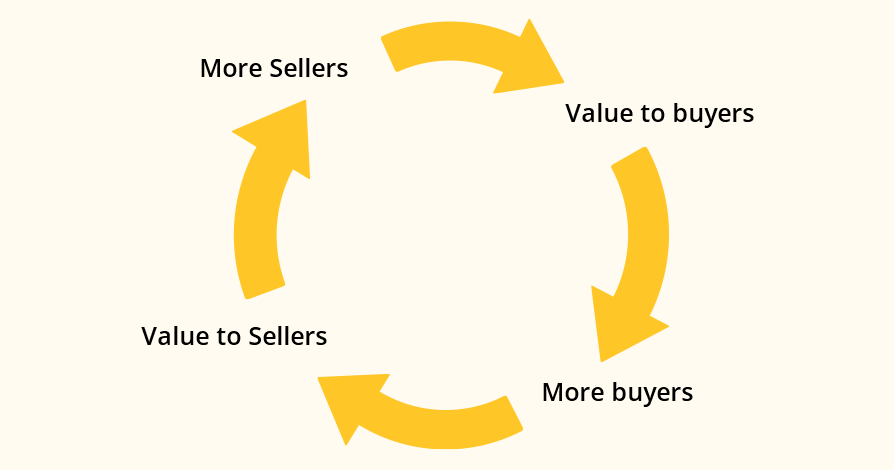
(Chicken and egg problem exists when users on one side find the platform useful only if the other side exists)
So, who should you attract first?
Inviting sellers first is a safe choice. What a lot of marketplace founders do is to provide an economic incentive.
You can attract vendors and promise them a sea of customers with rewards and discounts once you establish your seller base.
For instance, when Uber was launched, it offered a minimum wage to drivers even if they did not get any ride. This helped them attract more drivers.
But…
With rewards, you can attract vendors/buyers. The question is will they be loyal?
You will be investing a lot in building and marketing your marketplace. So, you would want a sustainable outcome.
If someone gives even a 10% more discount than you do, your potential vendors/shoppers will not give a second thought. Therefore, you need a reliable strategy to find loyal customers.
Customer loyalty is the best asset. Loyal customers will not just drive repeat business, but they will also help spread the word.
Product Customization to Make B2C Marketplace Platform More Attractive & to Drive Customer Loyalty
The latest trend in eCommerce is product customization. As consumers expect customized products, brands give them the freedom to design their offerings using a design tool.
Customization can not only attract more users to your B2C eCommerce marketplace, but it also has the potential to increase conversions by improving the shopping experience.
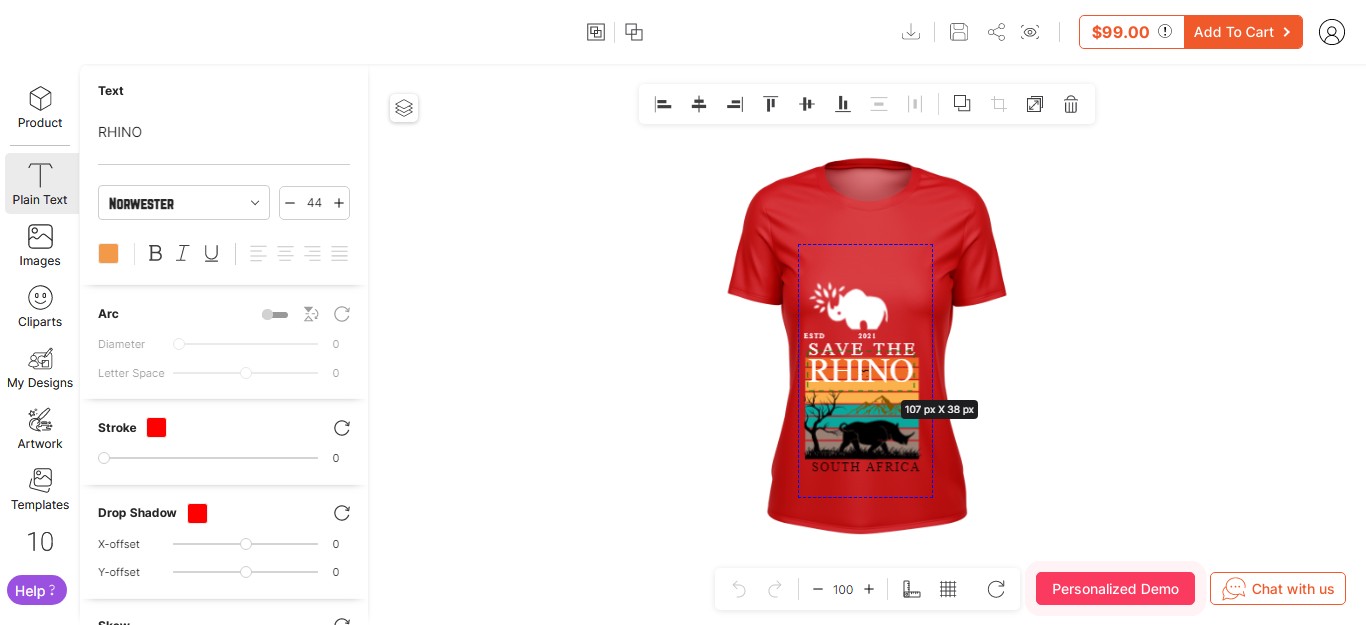
(A functional design tool for all eCommerce platforms)
Increase your brand awareness, and attract more vendors and sellers with the Product Design Tool.
Launch a B3C eCommerce marketplace with an added USP of customization.
Identify Who You Want to Target
This section covers everything you need to know about the types of B2C eCommerce and how you can find the target market.
Two Categories of Marketplace
The eCommerce marketplace business model falls into two categories: horizontal and vertical. A horizontal model is where you cater to the needs of more than one industry.
For instance, you are not just selling apparel but also offer goods like home appliances, stationary, electronic accessories, and so on.
It’s more of a one-stop shop like Amazon or Alibaba. So, in this model, you have a larger and broader customer base and cater to diverse needs.
A vertical marketplace, on the other hand, caters to a niche market. Etsy, for example, has a vertical model. Its focus is on unique and handmade goods. Here, you deliver goods of a specific category and to a narrow audience.
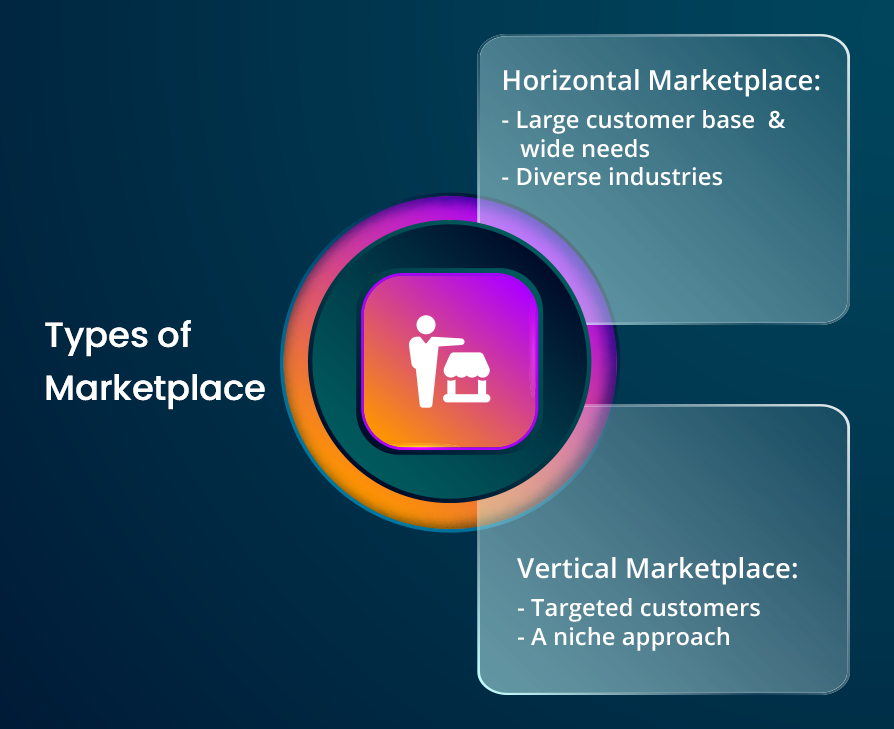
Which one to choose?
There is no good or bad model over here. You can choose a marketplace model depending on your goals.
Both have pros and cons. The horizontal approach gives you versatility and diversity. But catering to multiple industries comes with complications. You have to manage different types of users and categories at the same time.
Going vertical helps you conquer a single category, but that comes with some risk. It all depends on how a particular market performs. You are likely to face challenges if the market becomes volatile.
? Niche-specific marketplaces are gaining popularity.
Unlike horizontal models that have a vast and diverse customer base, niche-specific categories allow you to cater to a target audience.
That way, a focused and specific approach presents more opportunities to grow and succeed.
ASOS, for example, is a UK-based marketplace. It has a very well-defined audience: young shoppers. They have become a fashion giant selling over 80,000 products.

(ASOS smartly crafts posts that its target audience can relate to)
They even follow the niche strategy in their marketing campaigns. They keep sharing funny posts that resonate with their target market.
Ways to Find Target Audience
Identifying the target audience is an essential first step in developing a B2C eCommerce marketplace. The following points will help you define your target market.
1. Evaluate Your Competitors
The most important and the obvious thing when launching a business is to keep an eye on your competitors.
competitor analysis will give you an overview of how your competitors work and identify potential opportunities. You can identify your business’s value proposition and what makes you different from others. Asking such questions will help:
- What is their market share, and what pricing strategies do they use?
- What are the needs of their ideal customers?
- Do they regularly offer discounts?
- How do they market their platform?
With in-depth research, you can find out what different strategies you need to adopt to win the market.
2. Understand Your Customer Demographics & Psychographics
The only way to thoroughly understand your audience is to know both psychographics and demographics.
Demographics explain ‘who’ your buyer is, while psychographics explain ‘why’ they buy. Demographic information includes gender, age, income, etc. Psychographic information includes belief systems, values, goals, and attitudes — the driving forces behind purchasing decisions. – HubSpot
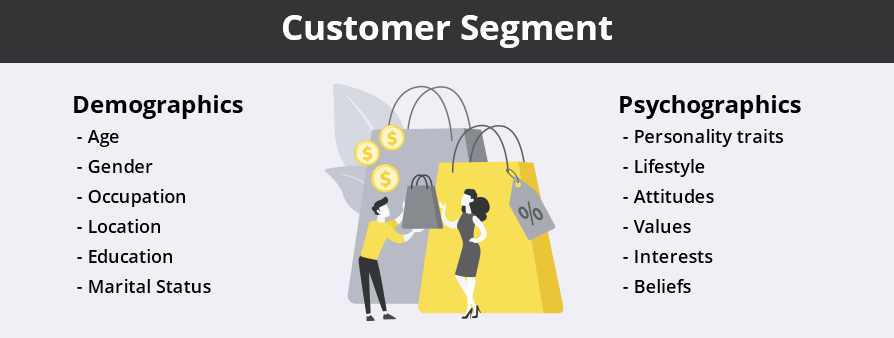
To better understand these aspects, create detailed buyer personas. Buyer personas are fictional representations of your ideal buyer.
You can create a persona by adding a name, demographic details, interests, personality, etc. That will help you understand their goals and buying patterns.
3. Identify Solutions that Your Business Offers
If you can identify and solve a pain point, your target market will flock towards you.
Customer pain points are problems your customers face in their day-to-day life, which you can solve through your products or services. These issues could be anything from financial pain points to customer service pain points.
You can find common problems customers face by conducting market research. If you already have products, look for ways to make them better. Check customer reviews to find what more they want.
Secondly, always highlight features over benefits. Talk about how your business can benefit the audience and what problem it solves. You can include such information on the product pages or website home page.
Have a project? Build a B2C marketplace platform customized as per your business goals.
Products Are Not Enough. You Need a Brand
Your customers no longer simply care about the products you offer. A great product is not enough to thrive in today’s marketplace. You need strong brand recognition to build trust.
A strong brand identity helps your audience differentiate you from the rest and positively influence their purchase decision.
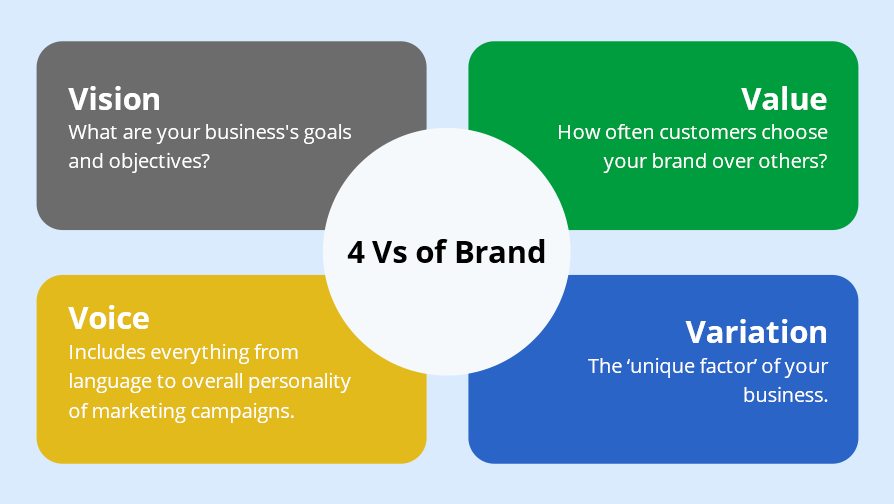
⭐ 4 Pillars of a Great Brand
Vision, voice, values, and variation are the four pillars that lay a strong branding foundation. Understanding them will help you build a successful and recognizable brand.
1. Vision
Brand vision basically refers to your goals, objectives, and intentions. A vision statement reveals the ‘where’ of your business – the direction and what impact you want to make.
Henry Ford: to make cars that ordinary people can afford.
Tesla: to accelerate the world’s transition to sustainable energy.
LinkedIn: create economic opportunities for every member of the global workforce.
How to create a vision statement?
Ask questions like what does your business do? What are you trying to achieve? Have a look at your products; identity what pain points you aim to solve. A statement that is simple, short, and clear is more impactful.
2. Voice
Brand voice is a distinct personality of your brand. It is the way you talk to your target audience. It includes everything from words and language to the personality and image your marketing strategy aims to deliver.
How to establish your brand voice?
A widespread thing that most brands do is create a voice chat. Choose three or five words that you think best represent your marketplace and its mission. It could be funny, helpful, authoritative, friendly, etc.
After considering your target audience, and brand vision, you can create the right message. For greater impact, try to reflect the same voice on all channels, including social media posts, emails, etc.
3. Values
Brand value is the monetary worth of your brand. It comes into the picture when your company merges or is bought by another business.
It also includes perceived worth – how often customers choose your brand over other alternatives. Once the audience finds value in your beans, they are likely to develop loyalty.
The right marketing and customer experience are the keys to building brand value.
4. Variation
The fourth V is variation. It is that factor that differentiates your brand from others. It could be price, shopping experience, customer support, and so on.
All the points discussed before, like analyzing the market, understanding your customers, etc., will help you find that ‘unique factor’.
Let customization be a distinguishing factor in your marketplace.
In an online landscape with thousands of businesses selling the same products, you can gain traction by enabling customers to buy customizable products. With Product Design Tool, deliver greater experiences, and sell more.
Start with B2C marketplace development. Build a platform that delights users.
Choose Features that Deliver Success
Here’s a glimpse of must-have features you need to build a successful B2C online marketplace.
1. Easy Onboarding
Attracting new vendors to your marketplace is a huge challenge. With a user-friendly onboarding module, you can enable sellers/vendors to register on your platform. To make the process effective, include all the necessary information, and have easy navigation. Once you approve their registration, each vendor will get a personalized dashboard.
2. Request Approval
Approve, deny, and manage vendor requests with this module. Once you configure the approval tire from the backend, you will receive requests upon vendor registration. Once approved, a vendor will get a notification with account access details. In the same way, if you reject a request, a vendor receives a rejection email.
3. Admin Dashboard
Marketplace owners need a feature that enables them to monitor everything going on the platform and make changes accordingly. Using a dashboard, you can get a bird’s eye view of all details. It includes information like the number of vendors, total orders, pending requests, commission, reviews, catalog, and a lot more.
4. Notifications & Alerts
Sending real-time notifications is a great tactic to engage and re-engage users. Using this feature, an admin can send notifications related to registration, payment transactions, offers, etc. In this module, the vendors also get control over receiving alerts. From a dashboard, they can choose to turn alerts on/off.
5. Payment Modes
Payment management is a core feature of an online marketplace. The way you process payments influences the ability to retain customers. To be effective, you need to provide a robust payment system, multiple payment methods, follow security protocols, etc. With this feature, an admin can manage all transactions they make along with vendor details.
6. Product Design Tool Access
The trend of custom products is growing. With a design tool, you can attract more vendors and enable them to sell customized products. You can offer this feature as a USP on your marketplace. PrintXpand provides a feature-rich and functional design tool. Users can add a personal touch to all offerings using features like artwork, text editor, clipart, templates, image upload, and more.
7. Product Catalog Management
When selling online, one of the biggest challenges you face is to manage product data. Product catalog management enables you to streamline the process of managing an eCommerce catalog. This feature gives both admin and vendors the ability to organize catalogs. By having an organized product catalog, you can enable customers to make better decisions.
8. Order Management
eCommerce order management includes everything from order routing and printing to shipping and returns. This module aims to automate the entire process of order management and provide a centralized system. With this feature, marketplace vendors can accept orders directly from the end customers.
9. Web to Print Store
Every vendor who comes on your marketplace is an independent brand. A web to print store will allow them to set up their stores as per their brand logic. With easy-to-use themes, they can design their stores the way they want. Moreover, with powerful backend operations, they can streamline their business processes.
This was just a glimpse of what a marketplace includes. We can help you decide on features that deliver a seamless experience based on your requirements and industry.
Get in touch with us to build a feature-rich B2C online marketplace.
? A Visually Appealing & Functional Website to Win
Create the Best First Impression with Visuals
Now that you have the 4 Vs, it’s time to match your marketplace’s visual branding with them. Do you know it takes 1/10th of a second to form a first impression of someone?
In the same way, when it comes to a brand, it takes 50 milliseconds for the audience to form an opinion about your online store.

The three essential elements that help in building a visual identity are logo, colors, and typography.
A logo is a vital element in the branding process that helps in creating a memorable brand. In terms of visuals, it is simple, clean, and without any clutter. Additionally, it also communicates who you are and what your business stands for.
The typography and colors you choose also say a lot about your brand. Color has a deeper connection to emotions and psychology. Hence, it is important to choose colors that match your Brand Voice.
A company that does a good job is eBay. Its logo is simple and clear. The colorful letters reflect the company’s image of being a fun place to buy and sell products.
Get in touch with an expert team to launch your B2C eCommerce marketplace.
Easy Navigation, Checkout, and Such
During B2C marketplace development and designing, you have to think like a website visitor. There are a few things that potential customers expect – simple, free of clutter, easy to navigate, ample white space, etc.
> Checkout Should be a Breeze
The checkout page is the key step in driving conversions. All the efforts you put in to bring prospects on your marketplace fail if checkout is messed up.
According to research, 1 out of every five shoppers abandoned a cart due to a “too long/complicated checkout process.”
To reduce cart abandonment, and offer a seamless checkout, make the process simple and easy. Use simple graphics to avoid any confusion and set expectations.
> Make Categories Easy to Navigate.
The horror of horrors is a visitor having to click five different menus before they finally get what they are looking for. You have to make it easy for your customers to search for products.
When building a website, plan the navigation. Think about what pages your website requires, what will be the main pages, and what sub-categories.
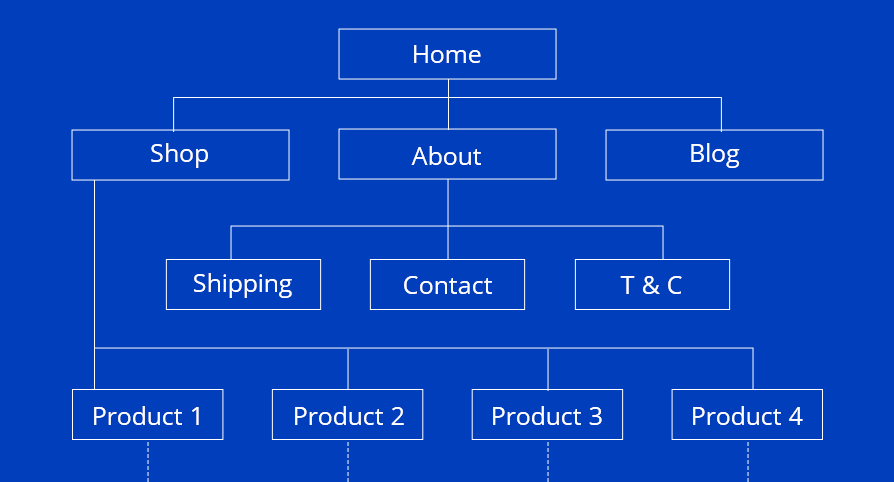
(Create a sitemap to list all pages on your website)
Apart from these, there are other essential things. For example, mobile responsiveness is a priority. With more people purchasing directly from mobile devices, it’s really important to consider a mobile-first approach.
Secondly, your website content should be easily scannable. It helps your audience to quickly understand the message. Use bullet points to make it easy to read, keep sentences and paragraphs short.
Do Not Forget eCommerce Fulfilment Process
It is imperative to include warehousing, packaging, delivery, etc., in your business plan when starting a B2C online marketplace. A well-thought fulfillment process will reduce expenses and quicken delivery.
How to handle eCommerce fulfillment?
There are three ways you can handle the fulfillment process. One is self-fulfillment. You manage all operations like storage, inventory, packaging, shipping, etc.
You also need to figure out how to handle printing for the B2C web to print marketplace. Are you going to set up a printing infrastructure or partner with a 3rd party?
The second model of fulfillment is dropshipping. Here, you do not hold any inventory. Once a customer places an order, the dropshipping provider takes care of the fulfillment process on your behalf.
Another way is to partner with third-party fulfillment providers. They provide you with access to a warehouse, inventory management system, shipping, and so on.
The cost of eCommerce fulfillment depends on the model you choose. Each model has its benefits and drawbacks. Review each model and decide as per your goals and requirements.
Does packaging matter?
eCommerce packaging is a defining aspect that makes or breaks your relationship with customers. Packaging is an important touchpoint in a buyer’s journey that helps in delivering greater experiences.
Designing effective product packaging begins by understanding your target audience.
Once you know who you are selling to and the product, use graphics to represent it. For instance, packaging for electronics will be different from packaging for stationery items.
Sustainable packaging design has become increasingly popular. You can make your business eco-friendly by using recycled packaging.
For a greater shopping experience, you can even enable users to customize their packaging with a design tool.
What about purchase returns?
Product returns are a headache for all businesses, no matter how big or small. If you do not handle returns correctly, they can be a large expense for your online business.
If you choose to partner with a logistics company, they will take care of everything from processing returns to issuing refunds.
Having a clear return policy on your website is a good business practice. It helps in building trust and gives a customer the confidence to buy from you.
Another way to reduce returns is to have every product listed with high-quality images and descriptions. When customers have a clear idea of what they will receive, they are less likely to return it.
Attracting Vendors and Buyers with Right Marketing
Here are a few tips that will help you promote your B2C online marketplace.
1. Reach Out to Vendors on Existing Platforms
There are hundreds of platforms where your potential vendors are active.
Begin your search with marketplaces like Amazon, eBay, etc. For instance, on Amazon, under the product name, you can find the vendor hyperlinked.
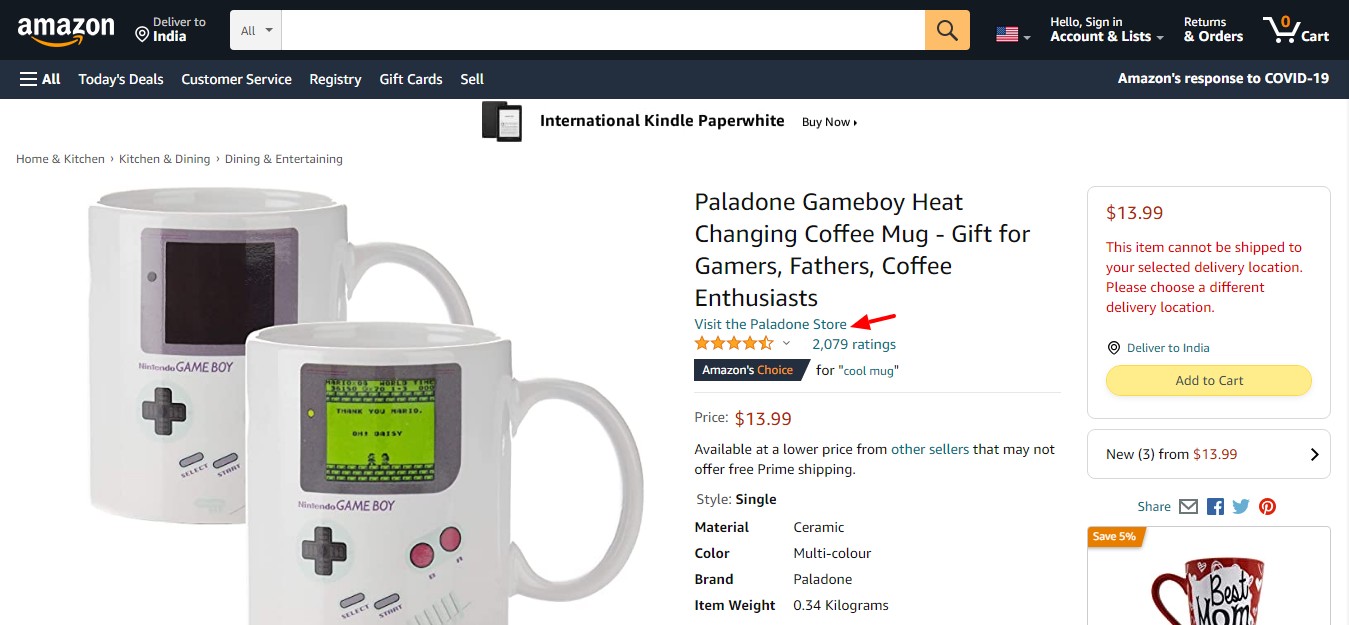
(Find sellers easily on Amazon)
Another good way to reach vendors is by joining groups and communities across different social media platforms. This will help you connect directly with them.
There are various online business listings like Yelp, Manta, etc., to search vendors for an eCommerce marketplace.
Once you have a list of vendors, you can reach out to them via direct call or email. Here you can provide incentives to convince potential vendors to sign up on your platform.
2. Provide an Efficient Monetization Model
A vendor’s decision to join your marketplace or not depends greatly on how much you charge. The majority of online marketplaces operate on these two revenue models.
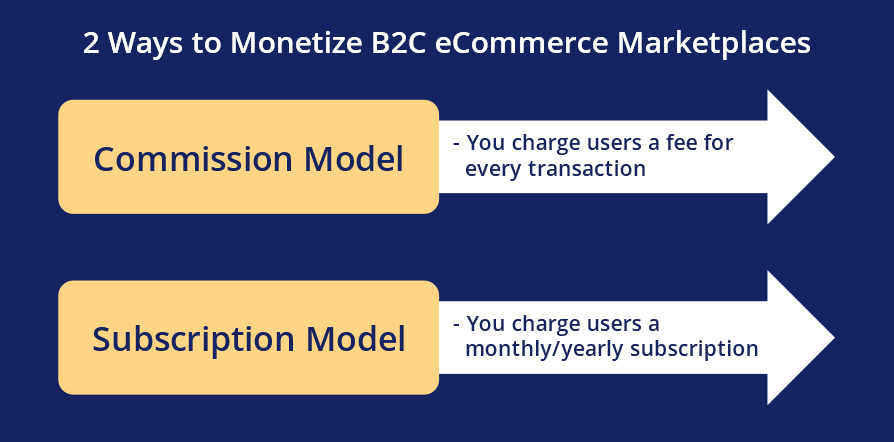
The first is a commission model. It is one of the most popular business models where you charge users a fee for every transaction. So, for any exchange that happens on the platform, admins get a portion of it. Popular companies like Amazon, eBay, Uber run on this model.
Second is the subscription model, where you charge users a regular fee to access your marketplace system. One of the biggest advantages of this is that it allows you to predict your monthly revenue on a regular basis.
3. Social Media is a Must
Social media is an excellent tool to promote your marketplace both pre and post-launch.
Before you officially launch your marketplace, create a buzz. Mostly, companies share a ‘coming soon’ post to keep people guessing. Social media countdown is also an excellent way to remind followers of your platform launch.
One week until launch!! ✨😱 pic.twitter.com/nzrXwFKBm0
— Rainway (@RainwayApp) January 24, 2019
(Coming soon or countdown make for a great social media post pre-launch)
One way to master social media strategy is to balance between selling and sharing. You do not want to appear too salesy. By sharing relevant content, you can drive greater engagement.
Also, remember to keep track of social media analysis. Tracking and analyzing data will help you draw actionable conclusions.
4. Drive Organic Traffic with SEO
SEO comprises various activities that help your website rank. The higher your website is in the Search Engine Result Pages, the more organic traffic you receive.
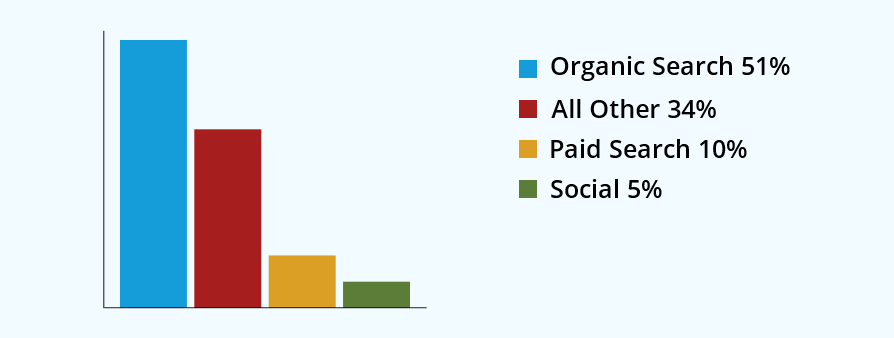
(Organic search is 51%. Leverage the power of SEO to gain benefits)
The most important aspect of SEO is keywords. Picking the right keywords will help you get in front of the right users looking for your offerings.
Tools like Google Keyword Planner will help you in understanding search volume and choosing relevant keywords.
Build, launch, and market B2C web to print marketplace with PrintXpand.
Build a B2C eCommerce Marketplace with Us
Building a marketplace comes with a number of risks. With the right strategy and assistance from a tech team, you can avoid potential challenges.
PrintXpand has everything you need to launch your marketplace successfully. We provide B2C marketplace development services to build secure, scalable, and engaging platforms with the best user experience.
In our 14+ years of experience, we have helped entrepreneurs like you build and grow their online businesses. Guided by business consultants and skilled technical experts, get started with marketplace development.
Get in touch to discuss your project.
All product and company names are trademarks™, registered® or copyright© trademarks of their respective holders. Use of them does not imply any affiliation with or endorsement by them.
